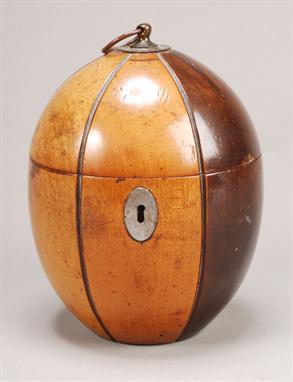We found 81449 price guide item(s) matching your search
There are 81449 lots that match your search criteria. Subscribe now to get instant access to the full price guide service.
Click here to subscribe- List
- Grid
-
81449 item(s)/page
A Victorian lacquered faux agate and brass bound tea caddy, late 19th century, of rectangular form, the cover, front and sides with incised and inset mock clasps, the interior with twin subsidiary satinwood covers with ebonised moulding and metal lining beneath, 13cm high, 23.5cm wide; a faux malachite papier mache casket, third quarter 19th century, 12.5cm wide; and a Dutch parquetry veneered wood casket, 19th century, 19cm wide
A George III fruitwood tea caddy in the form of a melon, late 18th century, the hinged cover with brass ring handle, the body with six vertical linear divisions, one of the sections being possibly of plumwood, another with the remnants of a stained finish, the interior with traces of metal lining, 14cm high overall
A Victorian tortoiseshell veneered and pewter strung tea caddy, third quarter 19th century, with pagoda top and serpentine front, on four coquilla nut feet, the hinged cover opening to ivory banding and twin subsidiary covers with further tortoiseshell veneers, 14.5cm high, 20cm wide, 12cm deep, (losses, damage)
A George III mahogany, marquetry and crossbanded tea caddy, circa 1800, of rectangular form, the hinged top and front with inset shell paterae, the interior with twin subsidiary covers, 11.5cm high, 21cm wide; and a Victorian mahogany and verre eglomise inset table coaster, mid 19th century, of circular form, the underside with three castors and inscribed WILLIAM BRYDEN & SON, 55 GEORGE STREET, EDINBURGH, 24cm diameter
A German Vienna style carved walnut grande sonnerie wall regulator, late 19th century, the triple weight movement striking the hour with every quarter on gongs (one detached), the going train with deadbeat escapement and wood rod pendulum, the backplate stamped with G.V.R.M. trademark and numbered 100000 66391, the two-piece brass Roman numeral dial with foliate etched centre, the elaborate case with female mask centred scroll carved arched pediment above strapwork decorated frieze and squat baluster pilasters flanking dial, with conforming taller pilasters flanking the rectangular pendulum aperture beneath, the base with pendant spindle gallery and strapwork carved inverted caddy flanked by spherical finials (movement and case with faults), 153cm
A George II walnut eight-day longcase clock, Samuel Berry, London, circa 1735, the five pillar rack and bell striking movement with 12 inch brass break-arch dial with calendar aperture and subsidiary seconds dial to the matted centre within an applied silvered Roman numeral chapter ring with fleur-de-lys half hour markers and Arabic five minutes, the angles with cast female mask and foliate scroll spandrels beneath arch with silvered boss signed Samuel Berry, LONDON between dolphin cast mounts, the case with domed caddy and plain frieze to upstand above moulded cornice and three-quarter columns to hood, the trunk with convex throat moulding and break-arch door, on crossbanded plinth base with moulded skirt, 245cm high. Samuel Berry is recorded in Baillie, G.H. Watchmakers & Clockmakers of the World as being admiited as an apprentice in 1698, gaining his Freedom of the Clockmakers’ Company in 1705 and working until 1743.
A part canteen of Old English pattern table flatware and further items, in an oak canteen box with two lift out trays and mostly plated wares, including; six tea knives in a box, two fiddle pattern stuffing spoons, various further items of flatware, a teapot, two odd candlesticks, a pair of salts with pale blue glass liners, a tea caddy, a cigarette case, a bottle coaster, a pair of fish servers and further items.
-
81449 item(s)/page


































